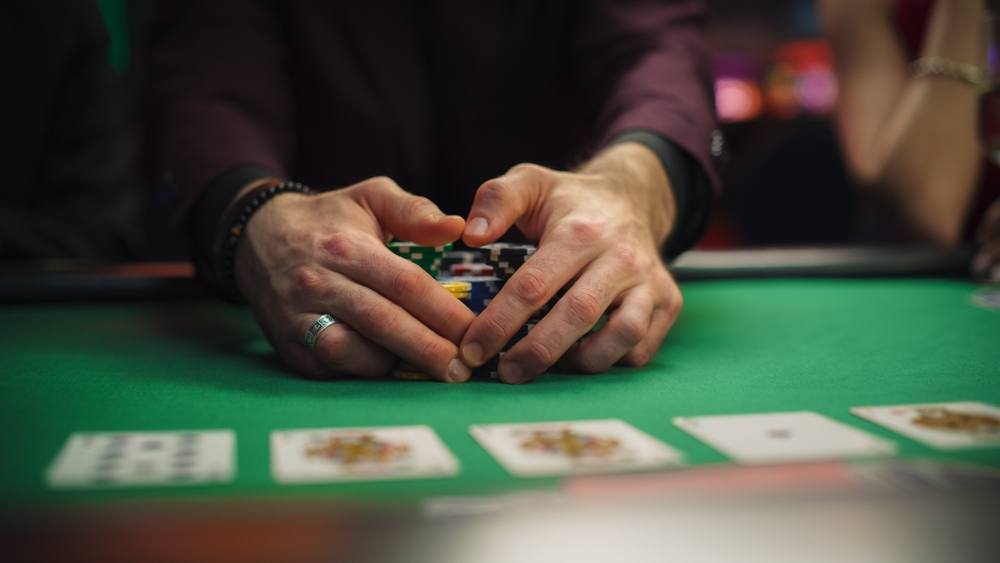- In online poker, equity refers to your share of the pot at any point in the game. An equity calculator helps ascertain these odds accurately.
- Using a poker equity calculator can help make informed decisions about whether to bet, call, raise, or fold, by providing a mathematical prediction of the game’s outcome.
- To calculate equity, you’ll need to input the cards you are holding, the cards on the table, and, optionally, hypothesized cards your opponent may be holding.
- The calculator will provide your hand’s equity as a percentage, illustrating your chances of winning at that specific moment in the game.
- Regular use of a poker equity calculator can aid in recognizing patterns, understanding specific hands, and enhancing overall poker strategy.
After several winning nights of poker around the kitchen table with friends, you may consider heading to a local poker room to test your luck against more seasoned players. However, these players donning their visors, sunglasses and headphones are playing a different game than you.
For many, poker is a means of testing their skills and mathematical abilities to seize the poker pot and push the beginner back out the door.
With a poker equity calculator, you’ll be better positioned to play more strategically and win more hands. Even if you’ve been playing for years, poker hand equity calculator can enhance your game play and increase your odds of winning.

Image: FabrikaSimf/Shutterstock
What is Equity in Poker?
Equity in poker is the amount of money you are likely to claim from the pot based on your current hand and your percentage of winning. In Texas Hold ‘Em, for example, you would look at the two cards in your hand and the community cards dealt, if any.
Then you calculate your share of the pot based on your odds and use it to determine your next move. If there is $100 in the pot and your chances of winning are 50%, then your equity is $50.
But you can’t win 50% of the pot, right? You either win or lose. What the equity will tell you is how much you would expect to win on average if you were to be in the same situation over multiple hands.
With 50% equity, you’re just as likely to win as you are to lose and, therefore, over multiple hands in that same situation the average you would walk away with is $50.
Why is Calculating Equity Important in Poker?
If you can calculate how much you’re likely to win in any given poker hand, it also gives you insight into how much your opponent can potentially lose. This is a poker strategy that players use to increase the value of the pot or get their opponents to fold.
If you raise your bet, you raise the equity in the hand. If there is $100 in the pot and you raise $50, your opponent can call or raise. If they call, the pot size grows to $200 and your $50 equity now becomes $100. Imagine if you had 75% equity, then your equity increases as well.
If you can use your equity knowledge to get them to fold based on your raise, you now realize 100% equity of the pot.
What are the Types of Equity Calculators?
There are several poker calculators available for both online and offline use. While the list of available poker equity calculators may be extensive, here is a short list of some of the more popular options:
1. Equilab: Equilab allows for in-depth analysis of hand equity, equity vs. ranges, and much more. It’s known for being highly-customizable and user-friendly but does require some time to understand its full features.
2. PokerStove: PokerStove is best known for its precise equity calculations. It’s easy-to-use and it’s free! The price of free means the equity calculations are basic; although it’s a good choice for beginners.
3. Flopzilla: Flopzilla analyzes equity, hand ranges, and board textures with a highly interactive interface. You have to pay for the software but it offers a lot of functionality.
4. RunItOnce: For more advanced equity calculations and a greater focus on strategy, RunItOnce is a good tool for analyzing hand strength and equity. RunItOnce is a subscription so beginners or casual players might be turned off by the cost.
There are many more options, which include more online, offline and mobile app versions ranging in a variety of prices.

Image: J E Cooke/Shutterstock
How to Use the Poker Equity Calculator
A basic poker equity calculator is fairly easy to use and can provide insight in moments.
- Once you open up the software or application, you’ll want to establish a new hand.
- Select or input the cards you hold. For example, if you hold the King of Spades and the Ten of Hearts, select these cards.
- Input any community cards that are on the table.
- If you know the opponent’s exact hand, you can input it. How would you know this? Many players will use a poker equity calculator to determine the equity of a hand post-play. This helps when playing future hands with similar situations
- If you don’t know the exact hand, you may have a range based on factors such as bet sizing and other tells.
- Run the calculation which will compute the equity of your hand against the opponent’s hand or range.
- Now you can check the equity percentages and see the likelihood of winning based on the current situation
Tips for Accurate Calculations
Just like when you’re learning how to play poker, there is a bit of a learning curve when it comes to calculating poker equity. Here are three tips to achieve more accurate calculations.
- Familiarize yourself with different features and options available in the calculator by practicing regularly.
- Take time to understand ranges and take note of common ranges for different positions and scenarios.
- Don’t limit yourself to a single tool. Try different calculators to find the one that best suits your style, expertise and overall intention.
Calculating Poker Odds and Equity
Determining the odds of winning versus losing a hand is key to mastering poker and something that must be top-of-mind during every moment of the game. Poker odds are simply the probability in which you’ll win or lose a hand. Every factor, from betting to raising to calling, will impact your odds.
Poker Odds vs. Poker Equity: What’s the Difference?
- Poker odds are the ratio of probability of something happening versus something not happening. For instance, what are the poker odds that your three of a kind will win?
- Poker equity refers to your share of the pot based on hand strength and possible outcomes.
While they are similar in nature and both can be used to determine whether or not you should raise, call or fold, equity is used to help make decisions based on the money in play and potential cards whereas odds are based on events happening or not happening.
The 2-4 Rule in Poker
The 2-4 rule in poker is a general guideline used to quickly assess the chances based on the number of outs you have (outs are the cards available that can improve your hand).
If you have a flush draw, you’ll want to know the likelihood of getting that fifth card to make the hand. If you have four spades between your hand and the flop, use the 2-4 rule to determine your chances of getting the flush. There are only 9 possible cards remaining that can give you the flush. To calculate getting that spade on the turn, you multiple 9 x 2 = 18. Therefore, there is an 18% chance of a spade coming on the turn.
If you want to calculate the odds of getting the flush with the turn or the river, multiply by 4. 9 x 4 = 36. The math says there’s a 36% chance.
Another example is calculating whether you can turn a pair of Aces into a three-of-a-kind. This time there are only two outs (the other two Aces):
- On the turn: 2 x 2 = 4%
- On the turn and the river: 2 x 4 = 8%

Image: RomanR/Shutterstock
Advanced Strategies for Poker Equity
Players can use equity and range analysis to determine their next best move. Instead of trying to figure out what your opponents specifically have, range analysis is used to consider a range of hands they might have. It’s almost like applying a series of if/then scenarios to determine your next move.
In Texas Hold ‘Em and Omaha Hold ‘Em, poker equity and range possibilities will constantly change as players make bets and new cards arrive in the flop, turn and river. Omaha is more complex because each player holds four cards instead of two. It can encourage players to stay in longer, which diminishes the equity of the pot.
Poker Hands and Their Equity
Here is a general breakdown of poker hands ranking from best to worst and their equity. With the exception of the Royal Flush, the true equity of each hand is specific to the situation.
| Hands | Equity Level |
| Royal Flush: 10 through Ace, all of the same suit. | 100% (this hand is unbeatable) |
| Straight Flush: Five consecutive cards of the same suit. | Extremely High |
| Four of a Kind: Four cards of the same rank | Very High |
| Full House: Three cards of one rank and two cards of another rank | Strong |
| Flush: Five cards of the same suit; they do not need to be in sequence | Good |
| Straight: Five consecutive cards (8 through Q); they do not need to be of the same suit | Moderate |
| Three of a Kind: Three cards of the same rank | Moderate |
| Two Pair: Two cards of one rank and two cards of another rank | Okay equity, but proceed with caution. The higher the rank of one pair, the better |
| Pair: Two cards of one rank | Weak |
| High Card: The highest rank in the hand if no other hands apply | Extremely Weak |
Poker Equity Calculators FAQs
I’m a Beginner Poker Player. What do You Suggest?
The best way to learn how to use a poker equity calculator is get started and learn as you go. However, consider free video poker to give you the freedom to take your time and discover how to calculate poker equity with each hand. Once you’re comfortable, ease into live betting.
When Should I Use a Poker Equity Calculator?
Every time you play to understand your chances of winning a pot. After you’ve played a hand, you can review the game and calculating poker equity. This will show the impact of the decisions you made and you can learn what you could have done differently based on the outcome. If you lose the hand, you can use the Poker Equity Calculator to examine the other players’ thinking processes.
Are Poker Odds Calculators Allowed Online and in Casinos?
This is dependent on the establishment. There are some online poker sites that do not allow it so make sure to read their rules before playing. Most live dealer poker games within a casino or establishment prohibit poker equity calculators at the table, as well as most electronic devices.
Are There Additional Resources and Tools Available to Help Improve my Poker Game?
Check out this downloadable Poker Odds guide There are several websites and apps listed above that provide Poker Equity Calculators
- Dive into advanced Pre-Flop Raise (PFR) strategies to elevate your poker game and gain a competitive edge at the casino table.
- Explore insights from poker statistics and analysis to understand the impact of PFR poker on hand ranges, aggression levels, and overall gameplay dynamics.
- Learn how to adjust your PFR poker range based on position, stack sizes, opponent tendencies, and table dynamics for strategic advantage.
- Implement sophisticated PFR tactics, such as 3-betting and balancing ranges, to exploit opponents and maximize profitability.
- Master the art of PFR poker by combining technical expertise with psychological insights to outplay opponents and achieve consistent success in your games.
Every possible edge in Texas Hold ‘Em can lead to better outcomes and, let’s face it, the fewer opponents you have the better odds you have of winning. One of the advanced strategies in Texas Hold ‘Em is known as the Pre-Flop Raise (PFR).
What is PFR in poker? A PFR Poker strategy is raising the bet before any community cards are revealed (pre-flop). At the beginning, the only money in the pot is from the big blind and small blind. After the hold cards are dealt, the first round of betting begins when players can bet, check, call or raise.
If you’re learning how to play poker and want to consider PFR, this article should prove the basic details to get you started and what to look out for.
Pre-Flop Raise as a Strategy
There are many reasons why PFR can be an important strategy and impacts gameplay in a variety of ways:
- Strong Hole Cards: The community cards can go any number of ways but if you’re holding two strong cards, you can raise before the flop to indicate and scare away potential opponents and/or build the pot.
- Minimize competition: If another player folds, that’s one less person who could potentially find favorable cards in the flop, turn or river. We’ve all been in the position where we fold bad cards only to discover they could have turned into a winning hand.
- Make Them Pay for the Flop: If you have a good hand, don’t let the others see the flop for cheap. Your Pre-Flop Raise indicates your hand is strong and you deserve to play into the next round.
- Collecting Intelligence: If a player folds, they thought their hand was weak. However, if they call or raise, you now have information that they could be holding a strong hand as well.
- Psychological Warfare: If you PFR aggressively, you’re signaling to the others players that you’re not afraid to play and apply some pressure.
What Does the Pre-Flop Raise Percentage Mean?
To determine the PFR percentage, take the number of hands in which a player raises pre-flop versus the number of hands played. If a player raises 15 times out of 100 hands played, the percentage is 15%.
This is used to assess a player’s style and how aggressive or conservative they are and what strategy you can use against it.
Generally, a PFR percentage above 15% indicates they are more aggressive.

Image credit: RomanR/Shutterstock
What is VPIP?
Voluntary Put money In Pot, or VPIP, is a percentage of how often a player bets, calls or raises. This doesn’t include blinds because those bets aren’t voluntary. An example would be if out of 100 hands played, if you voluntarily put money in 50 times, the VPIP would be 50%.
The Relationship Between VPIP and PFR
The way in which VPIP and PFR are related is in regards to poker strategy and how players bet at the beginning of a hand. While VPIP can happen at any time, PFR obviously can only occur before the flop. However, whether you’re the player raising pre-flop or it’s someone else, it is a key indicator on someone’s betting style.
A player willing to raise pre-flop or has a high Volunteer Put money in Pot percentage plays more aggressively. They are willing to gamble more often, re-raise when prompted and pressure their opponents into calling.
On the opposite side of the spectrum is the player with a lower VPIP and someone more likely to call rather than bet. They tend to play hands more conservatively, which means they’ll play when they have a higher likelihood of winning and less likely to bluff.
Raising pre-flop and monitoring the VPIP of other players can provide you with information about opponents’ hands and force them to call, raise or fold in times they would otherwise make a different decision.
Is PFR higher than VPIP? Generally, no. Players are more likely to put money in voluntarily as the game progresses rather than pre-flop.
PFR Values in Different Poker Formats
Depending on the poker format, there are different values that PFR may have.
- PFR in Six-Max Games are tight-knit with only six players vying for the pot (as opposed to a 9-10 player format). Because this is a smaller game, the players tend to be aggressive. There is a tendency for more action and the game moves quicker. Players have a PFR percentage closer to 20-30% with the more conservative players still raising pre-flop around 15% of the time.
- PFR in Full Ring Games are played with more traditional PFR percentages because there are 9-10 players. Unlike in the six-man games, the aggressive players in full ring games have a PFR percentage closer to 15%. The more conservative players will raise pre-flop only about 5-8% of the time.
- PFR in Zoom Poker Games is fast-moving, as the name suggests, which means players who want to stay in will PFR aggressively. In a game in which if you fold, you get moved to a new table, there is a greater incentive to stick around and learn your opponents’ strategies. The most aggressive players can have a PFR percentage close to 30%. The likelihood of moving frequently means you have to change your strategy all the time.

Image credit: RomanR/Shutterstock
Exploiting Opponents Using PFR
If you can identify different player types with PFR while playing Texas Hold ‘Em, you’ll be better prepared to challenge your opponents and have an edge with your hand.
4 Types of PFR Players
Although these percentages will vary depending on whether you’re playing a Six-Man Game, Full-Ring Game or Zoom Game, the types of PFR player remains the same. For context, the below percentages are based on a Full-Ring Game.
- Aggressive Players play just like that: aggressively. They will have a PFR range between 12-20%, so it’s likely they will raise pre-flop in 1 out of 5 games. An aggressive players’ strategy puts pressure on the others and often forces them to either fold (reducing the number of opponents) or call (which raises the poker equity). Aggressive players tend to play when they have a perceived strong hand.
- Tight-Aggressive Players tend to PFR selectively. Most of the time they’ll do it because they have a strong hand. They’ll occasionally bluff and hope to make a hand in the community cards, or force the others to fold. ?Tight-aggressive players have a PFR between 8-12%.
- Tight-Passive Players will typically raise pre-flop if they have a good hand so they have a lower PFR percentage at around 5-8%.
- Loose Players are similar to aggressive players in that they have a high PFR percentage. The difference is that a loose player’s strategy is about playing more hands and being somewhat unpredictable. Loose players will PFR even if they don’t have a great hand and have a high PFR percentage range of 15-20%, sometimes more.
So, how do you combat these varying PFR players? You can adjust the way you play by reading other players at the table to throw them off-balance. If a player is aggressive and calling or raising, get more selective in when you call or raise and ignore the pressure to raise or call.
If the players are more passive, consider raising with more frequency. This applies pressure on your opponents to call or raise, which increases the pot size, or will make them fold so you can take more blinds.
What is a good VPIP and PFR?
A good VPIP and PFR can be dependent on how a player chooses to play poker.
- High VPIP and Low PFR: This type of player tends to call rather than raise unless they have a big hand. They likely won’t bluff and will play the cards, not their opponent.
- Low VPIP and Low PFR: This type of player only plays big if they have a big hand. They don’t mind folding and rarely play big.
- Medium VPIP and Low PFR: A medium VPIP means putting money in about a quarter of the time. They’re more likely a casual player who calls a lot of raises and won’t bet big unless they have a good hand. When they bet, assume they have a decent hand.
- Medium VPIP and Medium PFR: This is the ideal strategy. If you’re not used to playing this way, ease yourself into it. It’s not easy playing a possible junk hand to outwit your opponents.
Common Mistakes to Avoid
- Over-raising. With a high PFR percentage, you’re opening yourself to other aggressive players who might have better hands once the community cards are dealt. It’s okay to be aggressive, but consider your PFR percentage.
- Raising to see the cards. If you Pre-Flop Raise or call to see the flop cards, you might be delaying the inevitable. There’s no point in losing chips just to see how things play out in the flop.
- Failure to adjust. Poker is all about reading the other players. If you notice you’re at a table with aggressive players, failing to adjust is setting yourself up to make mistakes.
- Playing based on potential. If you overvalue your hand and PFR on the possibilities, you’re playing with hope and not strategy. Learning the difference between exploitative play and GTO play is important in maintaining balance in your game.

Image credit: Kitreel/Shutterstock
PFR Poker Strategy
- There are many reasons why PFR can be an important strategy and impacts gameplay in a variety of ways. It can help increase the pot, make others fold or be an aggressive move with strong hold cards, to name a few.
- Consider both PFR and VPIP, which is the percentage a player voluntarily puts money in the pot. Both provide insight into a player’s strategy.
- Depending on the poker format, a player may change their strategy.
- There are generally four types of PFR players: Aggressive, Tight Aggressive, Tight Passive and Loose players.
There are many guides that can help players continue their poker education and no shortage of articles like this one that provide insights into overlooked strategies and information to take to the poker table.
One of the best ways to learn is to jump into it. If you’re a regular at a casino, live dealer poker or online poker game, start paying more attention to PFR and VPIP and consider how to take advantage of the players and their preferred methods of play.
]]>